-REV-200.png)
HOCKEY 101
Time To Play
Street Hockey
Time to face off! Basically, there are three types of faceoffs:
Standard Faceoff: Opposing centers face each other with their sticks one foot apart on the ground. Be ready because the referee is going to drop the puck, and then it’s hockey time!
Stick-To-Stick Faceoff: Opposing centers face each other with their sticks on the ground and the puck in between them. Then you tap the ground and then your opponent’s stick three times (ground-stick, ground-stick, ground-stick) and go for the puck.
In-Bounding Faceoff: When the puck goes out of play, the last team to touch it loses possession. Players on the defending team must stand at least 10 feet from the spot where the puck went out of bounds, then the inbounding team puts the puck back into play. The inbounding player must make a pass before a shot on goal can be taken.
Ice Hockey
Anytime there is a stoppage in play in ice hockey there is a faceoff. The only faceoff used in ice hockey is the standard faceoff, where the referee drops the puck between two centers.
Stopping Play
During a game, play is stopped either after a goal, when the puck leaves the playing surface, when the referee calls a penalty or when a rules infraction occurs. When the referee blows the whistle that means to stop playing and listen for the call.
Scoring A Goal
A player is credited with scoring a goal when he/she is the last person to touch the puck before it enters the opponent’s net, usually the player who shoots the puck at the net.
Getting An Assist
An assist is awarded to the players who take part in the play immediately preceding the goal. For example, often times when a player scores a goal they receive help from their teammates in the form of a pass. As many as two players can get credited with an assist of a goal.
Rules
Street Hockey
Icing – Sending the puck from behind your own goal all the way past the opponent’s goal line without being touched by anybody on the other team. Play begins at the spot closest to where the puck was last touched.
If, however, the opposing goalie touches the puck when it reaches the other end, play continues as normal.
Ice Hockey
Icing – A player shoots the puck from behind the center line across the opponent’s goal line and the puck is not touched by an opposing player until it crosses the goal line. If the opposing team touches the puck first after it crosses the goal line, icing is called and a faceoff is held at the opposite end. If the team that shoots the puck touches it first after it crosses the goal line, icing is not called and play continues. Icing is not called when the team that shoots the puck is shorthanded or playing with fewer players on the ice than the other team.
Offside – There is only a center line in street hockey (no blue lines like in ice hockey). You’re offside if both your feet cross the center line into your opponent’s zone before the puck crosses the line.
Offside – Both skates of a player cross the opposing team’s blue line before the puck crosses the line.
Offside Pass – When a player passes the puck from his/her team’s zone (behind the center line) to a teammate who has already crossed the center line (before the puck) and is in the opposing team’s zone.
Offside Pass – When a player passes the puck from behind his/her own blue line to a teammate who has passed the blue line and is in the opposing team’s zone.
Out of Bounds – If the puck is knocked outside the playing surface, it’s out of bounds. The last team to touch it loses possession.
Out of Bounds – If the puck is knocked outside the playing surface, it’s out of bounds. Generally a faceoff is held where the puck was shot.
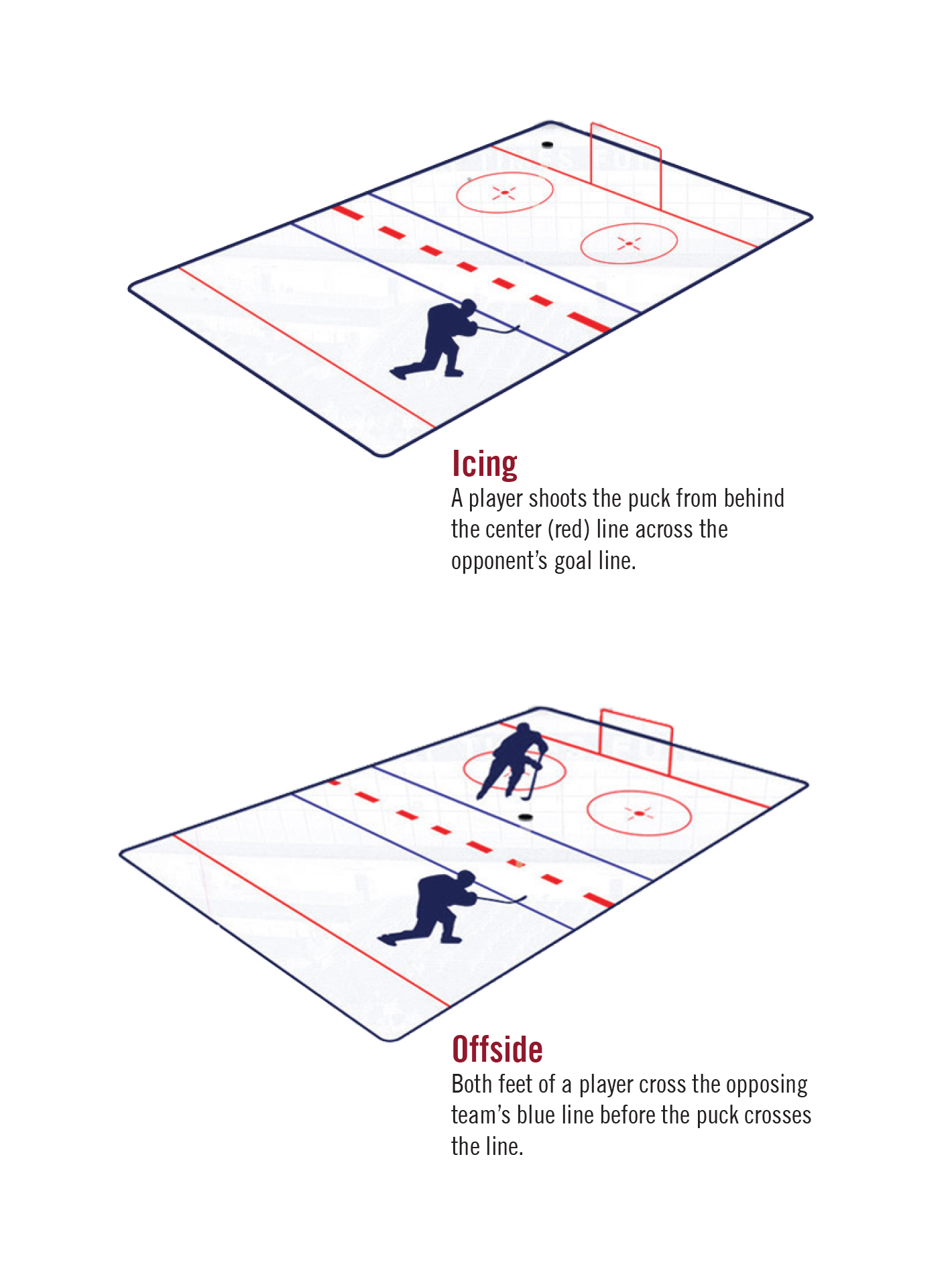
Penalties
Street Hockey
Penalties are strictly forbidden. The safety of all players is the first priority. If a penalty occurs, the player committing the penalty will be pulled from the game and will sit out for two minutes during which time his/her team will play shorthanded.
Penalty Descriptions
High Sticking – Keep your stick down. If you carry your stick above your waist you will receive a penalty.
Checking – Body checks are illegal in street hockey. Do not use your body to make contact with another player or force another player into a wall, barrier or out of bounds.
Interference – You may not interfere with another player who does not have the puck, force another player into a wall, barrier or out of bounds.
Charging – Charging is similar to checking. You can’t run, jump or fling yourself into an opponent.
Elbowing – No throwing elbows.
Slashing – No striking or slashing an opponent with your stick.
Fighting – If you fight, you will be removed from the game and face additional punishment.
Tripping – Knocking your opponent’s feet out from under them with your stick or feet is tripping.
Holding – You may not interfere with your opponent’s progress with your hands.
Hooking – You may not interfere with your opponent’s progress with your stick.
Ice Hockey
Ice hockey has major and minor penalties. If you break a rule, you go to the penalty box for a set amount of time while your team plays with one less player. This is known as a power play for the team with one extra skater. The team playing with fewer players is conside shorthanded.
Minor Penalty
A minor penalty is the most common form of penalty. A player who receives a minor penalty must sit in the penalty box and remain off the ice for two minutes. A double minor penalty requires a player to sit in the penalty box for four minutes. If a goal is scored against the team with fewer players the penalty ends immediately.
Major Penalty
A major penalty is a stronger degree of penalty for many of the same infractions that apply to minor penalties. A player who receives a major penalty must sit in the penalty box and remain off the ice for five minutes. If a goal is sco#8a2432 during a major penalty the penalty does not end.
Ice Hockey Penalty Descriptions
Boarding – Violently checking an opponent into the boards.
Slashing – Taking more than three strides or jumping before checking an opponent.
Cross-Checking – Hitting an opponent with both hands on the stick and then extending the arms while the check is being delivered.
Delay of Game – Imposed when a player or goalkeeper purposely delays the game in any way. For example, knocking the net off or clearing the puck over the glass in the defensive zone.
Elbowing – Using an elbow to strike an opponent.
Fighting – A fistfight between players.
High-Sticking – Striking an opponent with the stick above shoulder level.
Holding – Using your hands to grasp an opponent or his/her equipment.
Hooking – Impeding the forward progress of an opposing player by hooking him/her with the blade of the stick.
Interference – Impeding the progress of an opponent who does not have the puck or who is trying to gain possession of the puck.
Kneeing – Using your knee to impede an opponent.
Misconduct/Unsportsmanlike Conduct – Using abusive language or gestures or failing to follow a referee’s orders.
Roughing – Shoving or being involved in a minor altercation or scuffle, a less severe form of fighting.
Slashing – Swinging your stick and striking an opponent, thus impeding his/her forward progress.
Spearing – Using your stick in a stablike motion toward an opponent.
Tripping – Tripping an opponent with your stick or any part of your body.
Referee’s Signals
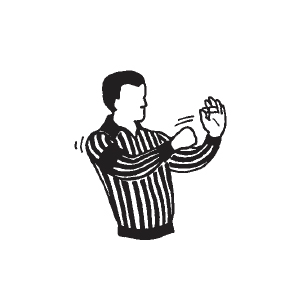
Boarding
Pounding the closed fist of one hand into the open palm of the other hand

Charging
Rotating clenched fists around one another in front of the chest
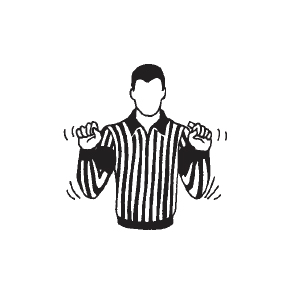
Cross Checking
A forward & backward motion with both fists clenched extending from the chest
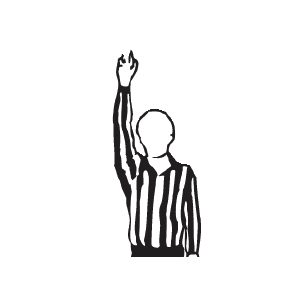
Delayed Penalty
Referee extends arm and points to penalized player

Interference
Crossed arms stationary in front of the chest with fists closed
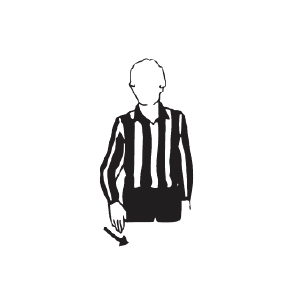
Kneeing
Slapping the knee with palm of hand while keeping both skates on the ice
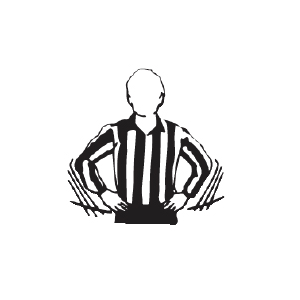
Misconduct
Place both hands on hips
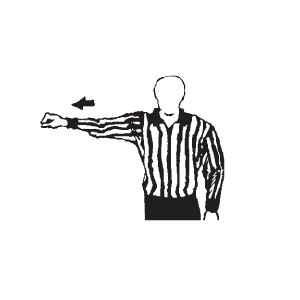
Roughing
A thrusting motion with the arm extended from the side
Linesman’s Signals
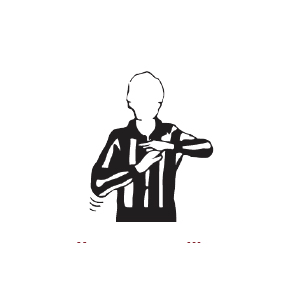
Unsportsmanlike Conduct
Use both hands to form a “T” in front of the chest
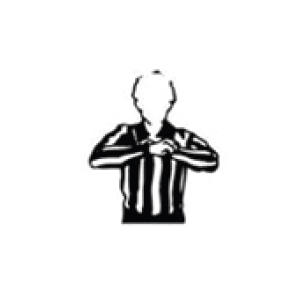
Icing
Linesman’s arms folded across the upper chest
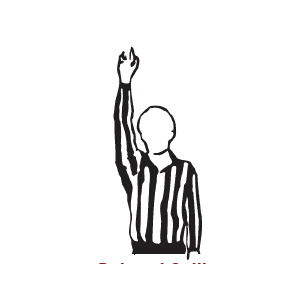
Slow Whistle
Arm in which the whistle is not being held extended above head. If play returns to neutral zone without stoppage of play, arm is drawn down the instant the puck crosses the line
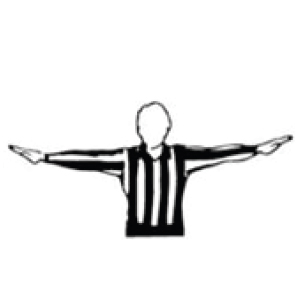
Wash-Out
Both arms swung laterally across the body with palms down… When used by the linesman it means no icing or no offside
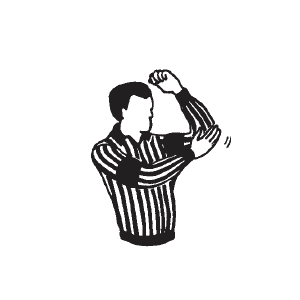
Elbowing
Tapping the elbow of the “whistle hand” with the opposite hand
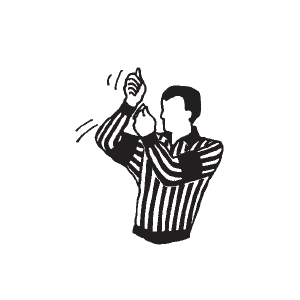
High Sticking
Holding both fists clenched, one above the other at the side of the head
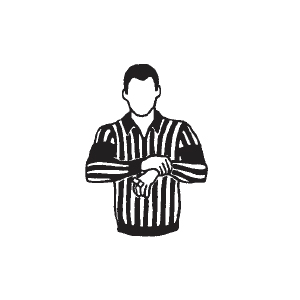
Holding
Clasping the wrist of the “whistle hand” well in front of the chest
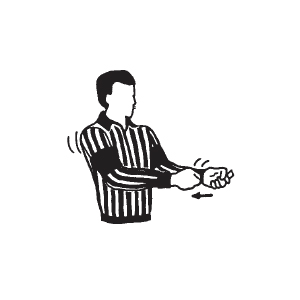
Hooking
A tugging motion with both arms, as if pulling something toward the stomach
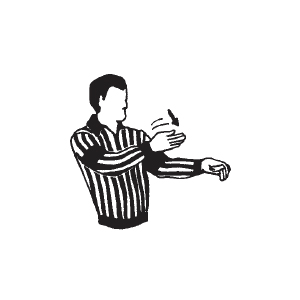
Slashing
A chopping motion with the edge of one hand across the opposite forearm
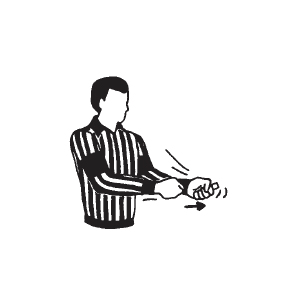
Spearing
A jabbing motion with both hands thrust out in front of the body
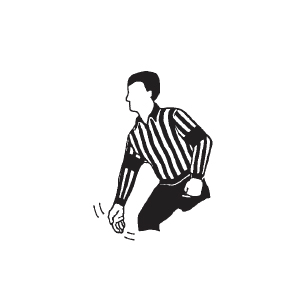
Tripping
Strike the right leg with the right hand below the knee keeping both skates on the ice

Wash-Out
Both arms swung laterally across the body with palms down… When used by the referee it means goal disallowed
© Colorado Avalanche Hockey 101. All Rights Reserved.
